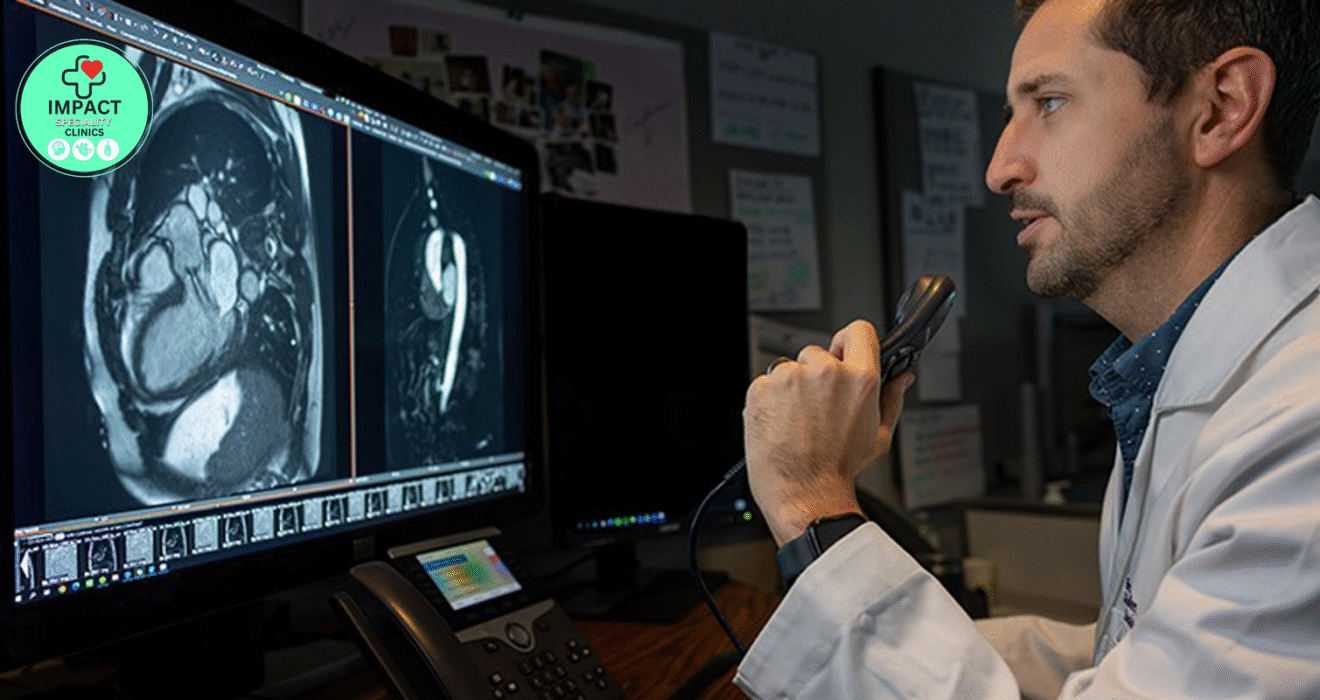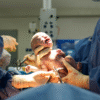Coronary Imaging Techniques (FFR, IVUS, OCT): What Patients Need to Know
When it comes to diagnosing and treating heart disease, precision is everything. Modern cardiology has evolved far beyond the days of basic angiograms and visual assessments. Today, interventional cardiologists rely on advanced coronary imaging techniques such as Fractional Flow Reserve (FFR), Intravascular Ultrasound (IVUS), and Optical Coherence Tomography (OCT) to visualize, measure, and analyze the arteries with microscopic accuracy.
These cutting-edge methods help determine the severity of blockages, guide complex procedures, and improve patient outcomes. In this comprehensive guide, Dr. Damodhar Reddy, a leading Interventional Cardiologist in Narsingi Hyderabad, explains how these technologies work, why they matter, and how patients benefit from their use at Impact Specialty Clinic.
Understanding Coronary Artery Disease and the Need for Precision
Coronary Artery Disease (CAD) occurs when plaque builds up inside the coronary arteries, restricting blood flow to the heart muscle. Over time, this leads to chest pain, breathlessness, or even a heart attack. Traditionally, doctors diagnosed CAD using angiography, which provides a two-dimensional X-ray image of the arteries.
While useful, angiography only shows the outline of the arteries — not the detailed structure of the vessel wall or the composition of the blockage. That’s where FFR, IVUS, and OCT come in. These technologies give the Best Cardiologist in Hyderabad a three-dimensional, real-time view inside the arteries, helping them make informed decisions about whether a blockage truly needs intervention.
1. Fractional Flow Reserve (FFR): Measuring the Blood Flow
Fractional Flow Reserve (FFR) is an advanced diagnostic technique used during coronary angiography to assess the impact of a blockage on blood flow. It involves inserting a special pressure wire through the artery to measure pressure differences before and after the narrowed area.
How FFR Works
- A fine pressure wire is inserted into the coronary artery.
- The cardiologist measures pressure before and beyond the suspected blockage.
- A ratio is calculated (FFR value).
- If the FFR value is below 0.80, it suggests the blockage significantly reduces blood flow and likely requires angioplasty or stenting.
Why FFR Matters
FFR provides real-time functional assessment of coronary lesions, distinguishing between blockages that need treatment and those that don’t. This helps prevent unnecessary procedures, making treatment safer and more effective.
As a Complex angioplasty specialist in Hyderabad, Dr. Damodhar Reddy uses FFR extensively at Impact Specialty Clinic to ensure patients receive precise, tailored care.
2. Intravascular Ultrasound (IVUS): Seeing Inside the Arteries
Intravascular Ultrasound (IVUS) uses sound waves to generate cross-sectional images of coronary arteries from the inside. A miniature ultrasound probe is mounted on a catheter and inserted into the artery.
What IVUS Reveals
- The thickness of the artery wall
- The size and composition of plaques
- The exact diameter of the artery for accurate stent placement
Clinical Advantages of IVUS
- Provides information on plaque burden and vessel remodeling
- Detects hidden lesions invisible on angiograms
- Guides stent sizing and deployment
- Confirms the success of angioplasty
IVUS is particularly valuable during complex angioplasty procedures. For example, in patients with heavily calcified or bifurcated lesions, IVUS helps the Best Cardiologist in Hyderabad plan the procedure with minimal risk.
At Impact Specialty Clinic, IVUS is part of the standard diagnostic protocol for advanced coronary interventions. It empowers cardiologists like Dr. Damodhar Reddy, a trusted Interventional Cardiologist in Narsingi Hyderabad, to perform life-saving procedures with exceptional accuracy.
3. Optical Coherence Tomography (OCT): The Next Generation of Imaging
Optical Coherence Tomography (OCT) takes coronary imaging to an even higher level of precision. It uses light waves instead of sound waves to create ultra-high-resolution images (up to 10 times clearer than IVUS).
How OCT Works
- A thin optical fiber emits near-infrared light inside the artery.
- Reflected light signals are captured to construct detailed images.
- The system visualizes the vessel microstructure in near-microscopic detail.
What OCT Helps Detect
- Plaque composition (fibrous, lipid-rich, or calcified)
- Stent apposition and expansion
- Tiny vessel tears or dissections
- Microthrombi and plaque erosion
With OCT, Dr. Damodhar Reddy, a Complex angioplasty specialist in Hyderabad, can detect even the smallest imperfections post-stent placement, ensuring the best possible outcomes for every patient at Impact Specialty Clinic.
Choosing Between FFR, IVUS, and OCT: The Cardiologist’s Decision
Each imaging method has unique advantages, and the choice depends on the clinical situation:
| Technique | Best For | Key Advantage |
|---|---|---|
| FFR | Assessing blood flow | Functional assessment of lesion significance |
| IVUS | Visualizing artery structure | Deep wall imaging, plaque burden detection |
| OCT | High-resolution imaging | Microscopic detail of vessel wall and stents |
A skilled Interventional Cardiologist in Narsingi Hyderabad like Dr. Damodhar Reddy often uses these tools in combination. For instance, FFR can determine if a blockage restricts blood flow, while IVUS or OCT guides stent placement with unmatched precision.
At Impact Specialty Clinic, this integrated approach ensures that patients get the right treatment at the right time — improving safety, reducing complications, and enhancing long-term heart health.
Benefits of Advanced Coronary Imaging for Patients
1. Accurate Diagnosis
Traditional angiograms can sometimes misjudge the severity of blockages. FFR, IVUS, and OCT give a detailed and functional assessment, helping the Best Cardiologist in Hyderabad identify exactly which arteries require treatment.
2. Personalized Treatment Plans
Every patient’s heart anatomy is different. These imaging tools allow Dr. Damodhar Reddy to design a personalized intervention strategy — especially during complex angioplasty cases at Impact Specialty Clinic.
3. Improved Stent Outcomes
By guiding precise stent placement and ensuring optimal expansion, IVUS and OCT help reduce the risk of stent thrombosis and restenosis.
4. Fewer Complications
When the cardiologist has real-time visualization of artery structure, the likelihood of procedural errors or complications drops dramatically.
5. Long-Term Success
Accurate diagnosis and precise intervention translate to better recovery, fewer repeat procedures, and improved heart function in the long run.
Why Choose Dr. Damodhar Reddy for Advanced Cardiac Imaging?
With years of expertise in interventional cardiology, Dr. Damodhar Reddy is recognized as one of the Best Cardiologists in Hyderabad. His approach combines innovation, experience, and compassion — ensuring every patient gets the most advanced cardiac care available.
At Impact Specialty Clinic, patients receive the benefit of cutting-edge technologies like FFR, IVUS, and OCT, alongside world-class post-procedure follow-up care. The clinic’s patient-centered model ensures comprehensive treatment — from early diagnosis to long-term prevention.
The Role of Advanced Imaging in Complex Angioplasty
For patients with multi-vessel disease, chronic total occlusions, or left main artery lesions, precision is paramount. Dr. Damodhar Reddy, a Complex angioplasty specialist in Hyderabad, uses FFR, IVUS, and OCT to:
- Plan stent size and length accurately
- Avoid unnecessary stent placements
- Confirm complete blockage removal
- Minimize risk of complications
This approach aligns with global best practices, making Impact Specialty Clinic a trusted center for interventional cardiology in Hyderabad.
Empowering Patients with Knowledge
Understanding these coronary imaging techniques helps patients participate more actively in their treatment. If your cardiologist recommends FFR, IVUS, or OCT, it’s because they provide vital information that improves safety and effectiveness.
At Impact Specialty Clinic, the focus is always on transparency and education. Patients are encouraged to ask questions, review their imaging results, and understand the rationale behind each treatment decision.
Conclusion
Modern cardiology is about precision, personalization, and prevention. Techniques like FFR, IVUS, and OCT represent the future of heart care — ensuring that every diagnosis and procedure is supported by data-driven insights.
When you consult Dr. Damodhar Reddy, a leading Interventional Cardiologist in Narsingi Hyderabad, you’re not just getting a treatment — you’re getting a complete, technologically advanced evaluation that prioritizes your heart’s long-term health.
For patients seeking the Best Cardiologist in Hyderabad, Impact Specialty Clinic stands out for its commitment to innovation, accuracy, and compassionate care. Whether it’s a routine heart check or a complex angioplasty, you can trust that you’re in the safest hands.
📞 Contact Us
Your heart deserves expert care guided by precision and compassion. Visit Impact Specialty Clinic today.
📍 Address:
Impact Specialty Clinic, 2nd Floor, SVR Complex, Narsingi, Hyderabad
📞 Phone / WhatsApp: +91 7075352525
✉️ Email: info@impactspecialityclinics.com
🌐 Website: https://impactspecialityclinics.com




